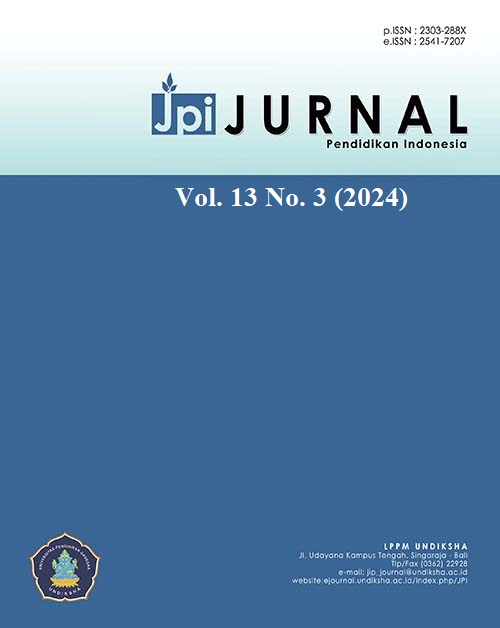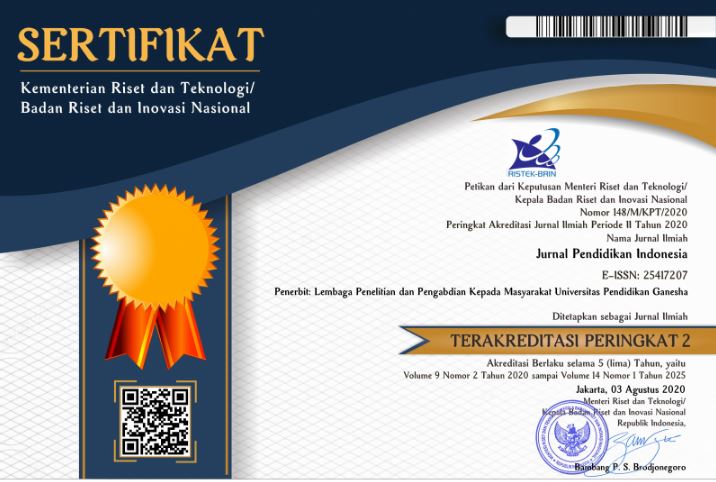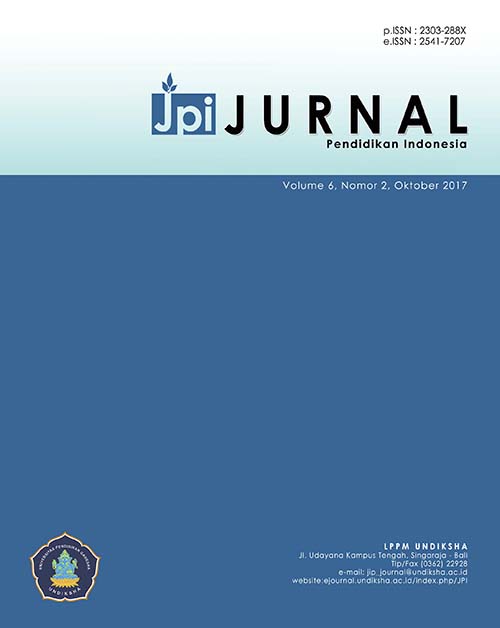The CSPOFL: Assessing College Students’ Perception of Flexible Learning Using the Multimodal Model of Online Education
DOI:
https://doi.org/10.23887/jpiundiksha.v13i3.82883Keywords:
Flexible Learning, Instrument, Online Education, Student Perception, Validation, TechnologyAbstract
Online or flexible learning has increased drastically even before the sudden change in educational modalities related to COVID-19. This study aims to design and validate the student perception of flexible learning (CSPOFL) through an instrument based on the multimodal online education model, which consists of seven constructs. This applied research uses an instrument development design and validation design after testing the validity and reliability of eight content experts and 164 students at a state university. The data collection method uses a questionnaire. The data collection instrument was used with a questionnaire sheet. The data analysis technique uses quantitative and qualitative analysis. The results of the study are from 55 initial items; the final version of the instrument consists of 29 items. It was found that the modifications mentioned above in the constructs and items resulted in the consistency of the overall instrument reliability coefficient of 0.955, which implies the acceptability of the instrument for use. CSPOFL is recommended for teachers, schools, administrators, and policymakers who aim to assess how students perceive flexible learning so that necessary interventions can be formulated to improve the teaching and learning process.
References
Adda, H. W., & Buntuang, P. C. D. (2022). Promoting Transformative Learning Through Independent-Study Campus (MBKM) During the COVID-19 Pandemic. Al-Ishlah: Jurnal Pendidikan. https://doi.org/10.35445/alishlah.v14i3.1867.
Agormedah, E. K., Aduhenaku, E., Ayite, D. M. K., & Aporiansah, E. (2020). Online Learning in Higher Education during COVID-19 Pandemic: A case of Ghana. Journal of Educational Technology and Online Learning, 3(3), 183–210. https://doi.org/10.31681/jetol.726441.
Anderson, T., & Rivera-Vargas, P. (2020). A Critical look at Educational Technology from a Distance Education Perspective. Digital Education Review, 37, 208–229. https://doi.org/10.1344/der.2020.37.208-229.
Arrosagaray, M., González-Peiteado, M., Pino-Juste, M., & Rodríguez-López, B. (2019). A comparative study of Spanish adult students’ attitudes to ICT in classroom, blended and distance language learning modes. Computers and Education, 134(October 2018), 31–40. https://doi.org/10.1016/j.compedu.2019.01.016.
Batlolona, J. R., & Mahapoonyanont, N. (2019). Academic Learning Outcome And Creative Thinking Skills On Projectile Motion Topic. JPI, 8(1), 1–8. https://doi.org/10.23887/jpi-undiksha.v8i1.14524.
Bosch, C. (2016). Promoting Self-Directed Learning through the Implementation of Cooperative Learning in a Higher Education Blended Learning Environment. Doctoral Dissertation at North-West University.
Candrasa, L., & Cen, C. C. (2023). The Effect Of Teacher Teaching, Learning Methods And Students Perceptions On The Student’s Learning Achievement In Medan City. JPPI (Jurnal Penelitian Pendidikan Indonesia), 9(1), 449–456. https://doi.org/10.29210/020221737.
Cardoso, A. S., Bryukhova, S., Renna, F., Reino, L., Xu, C., Xiao, Z., Correia, R., Di Minin, E., Ribeiro, J., & Vaz, A. S. (2023). Detecting wildlife trafficking in images from online platforms: A test case using deep learning with pangolin images. Biological Conservation, 279(December 2022), 109905.1-9. https://doi.org/10.1016/j.biocon.2023.109905.
Chatterjee, R., & Correia, A.-P. (2020). Online Students’ Attitudes Toward Collaborative Learning and Sense of Community. American Journal of Distance Education, 34(1), 53–68. https://doi.org/10.1080/08923647.2020.1703479.
Cifuentes, L. (2021). A Guide to Administering Distance Learning. BRILL. https://doi.org/10.1163/9789004471382.
Colton, D. C. (2007). Designing and Constructing Instruments For Social Research And Evaluation. Jossey-Bass.
Cooper, V. A., Forino, G., Kanjanabootra, S., & Meding, J. von. (2020). Leveraging the community of inquiry framework to support web-based simulations in disaster studies. The Internet and Higher Education, 47. https://doi.org/10.1016/j.iheduc.2020.100757.
Cortina, J. (1993). What is coefficient alpha? An examination of theory and applications. Journal of Applied Psychology.
Denham, S. A., Bassett, H. H., Zinsser, K. M., Bradburn, I. S., Bailey, C. S., Shewark, E. A., Ferrier, D. E., Liverette, K. H., Steed, J., Karalus, S. P., & Kianpour, S. (2020). Computerized social-emotional assessment measures for early childhood settings. Early Childhood Research Quarterly, 51, 55–66. https://doi.org/10.1016/J.ECRESQ.2019.07.002.
Dumford, A. D., & Miller, A. L. (2018). Online learning in higher education: Exploring advantages and disadvantages for engagement. Journal of Computing in Higher Education, 30(3), 452–465. https://doi.org/10.1007/s12528-018-9179-z.
Dyck, M. J., Novotny, N. L., Blakeman, J., Bricker, C., Farrow, A., LoVerde, J., Nielsen, S. D., & Johnson, B. (2020). Collaborative student-faculty research to support PhD research education. Journal of Professional Nursing, 36(3), 106–110. https://doi.org/10.1016/j.profnurs.2019.11.002.
Fadillah, S., Fauzi, K. M. A., & Yus, A. (2020). The Effect of Problem Based Learning Model on Students Mathematic Representation Ability and Student Adversity Quotient at SD Islam Setia Nurul Azmi Medan. Budapest International Research and Critics in Linguistics and Education (BirLE) Journal, 3(3), 1456–1467. https://doi.org/10.33258/birle.v3i3.1214.
Funke, J. O. (2022). Literature Review of Project-based Learning. Journal of Educational Research and Policies, 4(7). https://doi.org/10.53469/jerp.2022.04(07).23.
Furqon, M., Sinaga, P., Liliasari, L., & Riza, L. S. (2023). The Impact of Learning Management System (LMS) Usage on Students. TEM Journal, 12(2), 1082–1089. https://doi.org/10.18421/TEM122-54.
Garrison, D. R., Anderson, T., & Archer, W. (1999). Critical Inquiry in a Text-Based Environment: Computer Conferencing in Higher Education. The Internet and Higher Education, 2(2). https://doi.org/10.1016/S1096-7516(00)00016-6.
Gilbert, G. P. (2016). Making Sense of Methods and Measurement: Lawshe’s Content Validity Index. Clinical Simulation in Nursing.
Gopinathan, S., Kaur, A. H., Veeraya, S., & Raman, M. (2022). The Role of Digital Collaboration in Student Engagement towards Enhancing Student Participation during COVID-19. Sustainability (Switzerland), 14(11). https://doi.org/10.3390/su14116844.
Gummesson, C., & Nordmark, E. (2012). Self-reflections in an online course – Reflecting learning strategies? Advances in Physiotherapy, 14(2), 87–93. https://doi.org/10.3109/14038196.2012.671848.
Gusteti, M. U., & Neviyarni, N. (2022). Pembelajaran Berdiferensiasi Pada Pembelajaran Matematika Di Kurikulum Merdeka. Jurnal Lebesgue : Jurnal Ilmiah Pendidikan Matematika, Matematika dan Statistika, 3(3), 636–646. https://doi.org/10.46306/lb.v3i3.180.
Harasim, L. (2017). Learning Theory and Online Technologies (2nd ed.).). https://doi.org/10.4324/9781315716831.
Hartshorne, R., Baumgartner, E., Kaplan-Rakowski, R., & Mouza, C. (2020). Special issue editorial: Preservice and inservice professional development during the COVID-19 pandemic. Journal of Technology and Teacher Education, 28(2), 137–147.
Havidz, H. B. H., & Mujakiah, N. (2023). The Effect of Learning Environment on Student Motivation and Student Achievement (Literature Review Study). International Journal of Psycology and Health Science, 1(1), 30–39. https://doi.org/10.38035/ijphs.v1i1.86.
Hidayat, T., Susilaningsih, E., & Kurniawan, C. (2018). The Effectiveness of Enrichment Test Instruments Design to Measure Students’ Creative Thinking Skills and Problem-Solving. Thinking Skills and Creativity, 29, 161–169. https://doi.org/10.1016/j.tsc.2018.02.011.
Huang, R. H., Liu, D. J., Tlili, A., Yang, & Wang, J. F. (2020). Handbook on Facilitating Flexible Learning During Educational Disruption: The Chinese Experience in Maintaining Undisrupted Learning in COVID-19 Outbreak Rights and Permissions Handbook on Facilitating Flexible Learning During Educational Disruption: The .
Kaplan-Rakowski, R. (2021). Addressing students’ emotional needs during the COVID-19 pandemic: A perspective on text versus video feedback in online environments. Educational Technology Research and Development, 69(1), 133–136. https://doi.org/10.1007/s11423-020-09897-9.
Karma, I. G. M., Darma, I. K., & Santiana, I. M. A. (2021). Blended Learning is an Educational Innovation and Solution During the COVID-19 Pandemic. International research journal of engineering, IT & scientific research, 7(1), 1–9. https://doi.org/10.21744/irjeis.v7n1.1176.
Kebritchi, M., Lipschuetz, A., & Santiague, L. (2017). Issues and Challenges for Teaching Successful Online Courses in Higher Education. Journal of Educational Technology Systems, 46(1). https://doi.org/10.1177/0047239516661713.
Khadka, J., Joshi, D. R., Adhikari, K. P., & Khanal, B. (2023). Teachers’ Humanistic Role in Teaching Mathematics Online during the COVID-19 Pandemic in Nepal. International Journal of Distance Education Technologies, 21(1), 1–19. https://doi.org/10.4018/IJDET.324951.
Kim, G., & Gurvitch, R. (2020). Online Education Research Adopting the Community of Inquiry Framework: A Systematic Review. Quest, 72(4), 395–409. https://doi.org/10.1080/00336297.2020.1761843.
Krisdiana, I., Masfingatin, T., & Murtafiah, W. (2018). The Development of Research-Based Learning Materials with Problem Solving and Problem Posing Oriented of Mathematics Statistics. Al-Jabar : Jurnal Pendidikan Matematika, 9(2), 147–160. https://doi.org/10.24042/ajpm.v9i2.2961.
Lavrentieva, O. O., Rybalko, L. M., Tsys, O. O., & Uchitel, A. D. (2019). Theoretical and methodical aspects of the organization of students’ independent study activities together with the use of ICT and tools. Educational Dimension, 1, 27–59. https://doi.org/10.31812/educdim.v53i1.3831.
Lawshe, C. . (1975). a Quantitative Approach To Content Validity. Personnel Psychology, 28(4), 563–575. https://doi.org/10.1111/j.1744-6570.1975.tb01393.x.
Liu, Y. (2019). Using reflections and questioning to engage and challenge online graduate learners in education. Research and Practice in Technology Enhanced Learning, 14(1), 3. https://doi.org/10.1186/s41039-019-0098-z.
Loseñara, J. M., & Jugar, R. R. (2023). Technological, pedagogical, and content knowledge of diploma in professional education graduates teaching biology. JPBI (Jurnal Pendidikan Biologi Indonesia, 9(1), 1–14. https://doi.org/10.22219/jpbi.v9i1.24070.
Mahajan, M. V, & Kalpana, R. (2020). A study of students’ perception about e-learning. Indian Journal of Clinical Anatomy and Physiology, 5(4), 501–507. https://doi.org/10.18231/2394-2126.2018.0116.
Maqableh, M., & Alia, M. (2021). Evaluation online learning of undergraduate students under lockdown amidst COVID-19 Pandemic: The online learning experience and students’ satisfaction. Children and Youth Services Review, 128(1). https://doi.org/10.1016/j.childyouth.2021.106160.
Martin, F., Stamper, B., & Flowers, C. (2020). Examining Student Perception of Readiness for Online Learning: Importance and Confidence. Online Learning, 24(2). https://doi.org/10.24059/olj.v24i2.2053.
Martoredjo, N. T. (2020). Pandemi Covid-19: Ancaman atau Tentangan bagi Sektor Pendidikan? Jurnal Pendidikan, 2(1), 1–15.
Maulida, I., Dibia, I. K., & Astawan, I. G. (2020). The Development of Social Attitude Assessment Instrument and Social Studies Learning Outcomes Grade IV on Theme of Indahnya Keragaman di Negeriku. Indonesian Journal Of Educational Research and Review, 3(1), 12. https://doi.org/10.23887/ijerr.v3i2.25823.
Micari, M., & Calkins, S. (2021). Is it OK to ask? The impact of instructor openness to questions on student help-seeking and academic outcomes. Active Learning in Higher Education, 22(2), 143–157. https://doi.org/10.1177/1469787419846620.
Nash, J. A. (2015). Future of Online Education in Crisis: A Call to Action. TOJET: The Turkish Online Journal of Educational Technology, 14(2).
Nguyen, T. (2015). The Effectiveness of Online Learning: Beyond No Significant Difference and Future Horizons. MERLOT Journal of Online Learning and Teaching, 11(2), 309–319.
Ole, F. C. (2020). Development and Validation of Teachers’ Practices on Formative Assessment Scale (TPFAS): A Measure Using Feedback Loop Model. International Journal of Education, 13(1), 53–62. https://doi.org/10.17509/ije.v13i1.24715.
Picciano, A. G. (2017). Theories and frameworks for online education: Seeking an integrated model. In Online Learning Journal (Vol 21, Number 3, bll 166–190). The Online Learning Consortium. https://doi.org/10.24059/olj.v21i3.1225.
Polit, D. F., Beck, C. T., & Owen, S. V. (2007). Is the CVI an acceptable indicator of content validity? Appraisal and recommendations. Research in Nursing & Health, 30(4), 459–467. https://doi.org/10.1002/nur.20199.
Regmi, K., & Jones, L. (2020). A systematic review of the factors – enablers and barriers – affecting e-learning in health sciences education. BMC Medical Education, 20(1), 91. https://doi.org/10.1186/s12909-020-02007-6.
Rohati, F., H., & Kusumah, Y. S. (2023). Perceptions of Prospective Mathematics Teachers on Online Learning during Covid-19 Pandemic: Difficulties, Strategy, and Satisfaction. JPI (Jurnal Pendidikan Indonesia, 12(3), 543–555. https://doi.org/10.23887/jpiundiksha.v12i3.55898.
Shishigu, A., Hailu, A., & Anibo, Z. (2018). Problem-based learning and conceptual understanding of college female students in physics. Eurasia Journal of Mathematics, Science and Technology Education, 14(1), 145–154. https://doi.org/10.12973/ejmste/78035.
Sombria, K. J. F., Celestial, D. L., Jalagat, C. G. M., & Valdez, A. G. (2023). Online Learning Through Google Classroom: Effects on Students Critical Thinking Skills in Chemistry. ASEAN Journal of Science and Engineering Education, 3(2), 193–210. https://doi.org/10.17509/ajsee.v3i2.49794.
Sulthonah, F. A., Mulyono, H., & Wan Ahmad, W. F. (2022). Psychometric Analysis of an Instrument Evaluating Students’ Acceptance of Online Platform to Support Online English Learning. JPI (Jurnal Pendidikan Indonesia, 11(4). https://doi.org/10.23887/jpiundiksha.v11i4.43797.
Tan, C. (2021). The impact of COVID-19 on student motivation, community of inquiry and learning performance. Asian Education and Development Studies, 10(2), 308–321. https://doi.org/10.1108/AEDS-05-2020-0084.
Tanis, C. J. (2020). The seven principles of online learning: Feedback from faculty and alumni on its importance for teaching and learning. Research in Learning Technology, 28(0). https://doi.org/10.25304/rlt.v28.2319.
Tchamyou, V. S. (2020). Education, lifelong learning, inequality and financial access: Evidence from African countries. Contemporary Social Science, 15(1), 7–25. https://doi.org/10.1080/21582041.2018.1433314.
Tiwari, D., Allen, M., Schulz, R., Gotts, B., Stewart, C., & Kaur, M. (2024). Title: Development and Content Validation of the Pediatric Dizziness Index (PDI. https://doi.org/10.21203/rs.3.rs-4441730/v1.
Tusriyanto, Nadiroh, Japar, Wahyudi, A., Aminudin, K., & Widayati, E. (2019). Improved of critical thinking skills and social skills for students through inquiry learning (Guided enquiry) based literacy on the subject of social sciences in class v. Opcion, 35(Special Issue 20), 2989–2921.
Washington, G. Y. (2019). The Learning Management System Matters in Face-to-Face Higher Education Courses. Journal of Educational Technology Systems, 48(2), 255–275. https://doi.org/10.1177/0047239519874037.
Wieser, D., & Seeler, J.-M. (2018). Online, Not Distance Education: The Merits of Collaborative Learning in Online Education. In A. Altmann, B. Ebersberger, C. Mössenlechner, & D. Wieser (Reds), The Disruptive Power of Online Education (bll 125–146). Emerald Publishing Limited. https://doi.org/10.1108/978-1-78754-325-620181008.
Yani, K. E. M., Parji, & Dewi, C. (2023). Educational Game Media Based on CAI in PPKn for Fourth Grade Elementary School. JPI (Jurnal Pendidikan Indonesia, 12(4), 690–704. https://doi.org/10.23887/jpiundiksha.v12i4.65037.
Downloads
Published
Issue
Section
License
Copyright (c) 2024 Jleian Mard Loseñara

This work is licensed under a Creative Commons Attribution-ShareAlike 4.0 International License.
Authors who publish with the Jurnal Pendidikan Indnesia agree to the following terms:
- Authors retain copyright and grant the journal the right of first publication with the work simultaneously licensed under a Creative Commons Attribution License (CC BY-SA 4.0) that allows others to share the work with an acknowledgment of the work's authorship and initial publication in this journal.
- Authors are able to enter into separate, additional contractual arrangements for the non-exclusive distribution of the journal's published version of the work (e.g., post it to an institutional repository or publish it in a book), with an acknowledgment of its initial publication in this journal.
- Authors are permitted and encouraged to post their work online (e.g., in institutional repositories or on their website) prior to and during the submission process, as it can lead to productive exchanges, as well as earlier and greater citation of published work. (See The Effect of Open Access)








